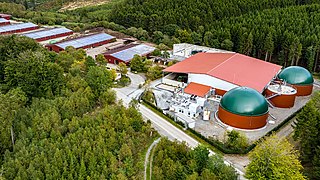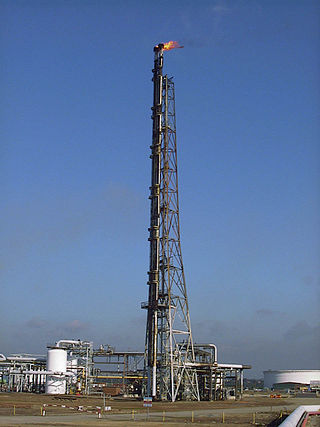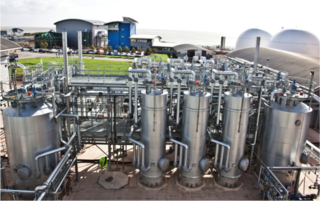
Biogas is a gaseous renewable energy source produced from raw materials such as agricultural waste, manure, municipal waste, plant material, sewage, green waste, wastewater, and food waste. Biogas is produced by anaerobic digestion with anaerobic organisms or methanogens inside an anaerobic digester, biodigester or a bioreactor. The gas composition is primarily methane and carbon dioxide and may have small amounts of hydrogen sulfide, moisture and siloxanes. The methane can be combusted or oxidized with oxygen. This energy release allows biogas to be used as a fuel; it can be used in fuel cells and for heating purpose, such as in cooking. It can also be used in a gas engine to convert the energy in the gas into electricity and heat.

Biofuel is a fuel that is produced over a short time span from biomass, rather than by the very slow natural processes involved in the formation of fossil fuels such as oil. Biofuel can be produced from plants or from agricultural, domestic or industrial biowaste. Biofuels are mostly used for transportation, but can also be used for heating and electricity. Biofuels are regarded as a renewable energy source. The use of biofuel has been subject to criticism regarding the "food vs fuel" debate, varied assessments of their sustainability, and possible deforestation and biodiversity loss as a result of biofuel production.
Cellulosic ethanol is ethanol produced from cellulose rather than from the plant's seeds or fruit. It can be produced from grasses, wood, algae, or other plants. It is generally discussed for use as a biofuel. The carbon dioxide that plants absorb as they grow offsets some of the carbon dioxide emitted when ethanol made from them is burned, so cellulosic ethanol fuel has the potential to have a lower carbon footprint than fossil fuels.

Anaerobic digestion is a sequence of processes by which microorganisms break down biodegradable material in the absence of oxygen. The process is used for industrial or domestic purposes to manage waste or to produce fuels. Much of the fermentation used industrially to produce food and drink products, as well as home fermentation, uses anaerobic digestion.

A biorefinery is a refinery that converts biomass to energy and other beneficial byproducts. The International Energy Agency Bioenergy Task 42 defined biorefining as "the sustainable processing of biomass into a spectrum of bio-based products and bioenergy ". As refineries, biorefineries can provide multiple chemicals by fractioning an initial raw material (biomass) into multiple intermediates that can be further converted into value-added products. Each refining phase is also referred to as a "cascading phase". The use of biomass as feedstock can provide a benefit by reducing the impacts on the environment, as lower pollutants emissions and reduction in the emissions of hazard products. In addition, biorefineries are intended to achieve the following goals:
- Supply the current fuels and chemical building blocks
- Supply new building blocks for the production of novel materials with disruptive characteristics
- Creation of new jobs, including rural areas
- Valorization of waste
- Achieve the ultimate goal of reducing GHG emissions

Iogen Corporation is a Canadian company based in Ottawa, Ontario, Canada, and was founded by Patrick Foody Sr. in 1975.

A gas flare, alternatively known as a flare stack, flare boom, ground flare, or flare pit, is a gas combustion device used in places such as petroleum refineries, chemical plants and natural gas processing plants, oil or gas extraction sites having oil wells, gas wells, offshore oil and gas rigs and landfills.
Bioconversion, also known as biotransformation, is the conversion of organic materials, such as plant or animal waste, into usable products or energy sources by biological processes or agents, such as certain microorganisms. One example is the industrial production of cortisone, which one step is the bioconversion of progesterone to 11-alpha-Hydroxyprogesterone by Rhizopus nigricans. Another example is the bioconversion of glycerol to 1,3-propanediol, which is part of scientific research for many decades.
Renewable natural gas (RNG), also known as biomethane, is a biogas which has been upgraded to a quality similar to fossil natural gas and has a methane concentration of 90% or greater. By removing CO2 and other impurities from biogas, and increasing the concentration of methane to a level similar to fossil natural gas, it becomes possible to distribute RNG via existing gas pipeline infrastructure. RNG can be used in existing appliances, including vehicles with natural gas burning engines (natural gas vehicles).

Sewage sludge treatment describes the processes used to manage and dispose of sewage sludge produced during sewage treatment. Sludge treatment is focused on reducing sludge weight and volume to reduce transportation and disposal costs, and on reducing potential health risks of disposal options. Water removal is the primary means of weight and volume reduction, while pathogen destruction is frequently accomplished through heating during thermophilic digestion, composting, or incineration. The choice of a sludge treatment method depends on the volume of sludge generated, and comparison of treatment costs required for available disposal options. Air-drying and composting may be attractive to rural communities, while limited land availability may make aerobic digestion and mechanical dewatering preferable for cities, and economies of scale may encourage energy recovery alternatives in metropolitan areas.

Digestate is the material remaining after the anaerobic digestion of a biodegradable feedstock. Anaerobic digestion produces two main products: digestate and biogas. Digestate is produced both by acidogenesis and methanogenesis and each has different characteristics. These characteristics stem from the original feedstock source as well as the processes themselves.

The Akshaya Patra Foundation is a non-profit trust of International Society for Krishna Consciousness (ISKCON), located in Bangalore, Karnataka, India. The organisation operates the Midday Meal Scheme in India.
China has set the goal of attaining one percent of its renewable energy generation through bioenergy in 2020.

Blue Marble Biomaterials, founded in 2007, is a US-based company which utilizes hybridized bacteria to produce specialty biochemicals and renewable biogas. The company develops and generates these biochemicals using non-virgin cellulose as biomass.

Thermal hydrolysis is a process used for treating industrial waste, municipal solid waste and sewage sludge.
Power-to-gas is a technology that uses electric power to produce a gaseous fuel. When using surplus power from wind generation, the concept is sometimes called windgas.

Lystek International is a Canadian waste treatment technology company founded in 2000 at the University of Waterloo, Ontario, Canada to commercialize treatment technologies for biosolids and other non-hazardous, organic waste materials. Lystek is headquartered in Cambridge, Ontario, Canada and is owned by its management and R.W. Tomlinson Ltd.

Reuse of human excreta is the safe, beneficial use of treated human excreta after applying suitable treatment steps and risk management approaches that are customized for the intended reuse application. Beneficial uses of the treated excreta may focus on using the plant-available nutrients that are contained in the treated excreta. They may also make use of the organic matter and energy contained in the excreta. To a lesser extent, reuse of the excreta's water content might also take place, although this is better known as water reclamation from municipal wastewater. The intended reuse applications for the nutrient content may include: soil conditioner or fertilizer in agriculture or horticultural activities. Other reuse applications, which focus more on the organic matter content of the excreta, include use as a fuel source or as an energy source in the form of biogas.
HTX is a Seychelles-based cryptocurrency exchange. Founded in China as Huobi, the company now has offices in Hong Kong, South Korea, Japan and the United States. In August 2018 it became a publicly listed Hong Kong company.

Fecal sludge management (FSM) is the storage, collection, transport, treatment and safe end use or disposal of fecal sludge. Together, the collection, transport, treatment and end use of fecal sludge constitute the "value chain" or "service chain" of fecal sludge management. Fecal sludge is defined very broadly as what accumulates in onsite sanitation systems and specifically is not transported through a sewer. It is composed of human excreta, but also anything else that may go into an onsite containment technology, such as flushwater, cleansing materials, menstrual hygiene products, grey water, and solid waste. Fecal sludge that is removed from septic tanks is called septage.












